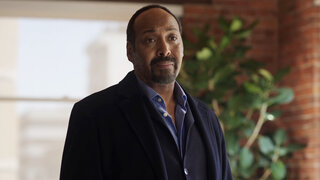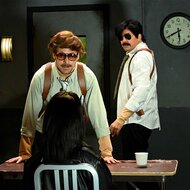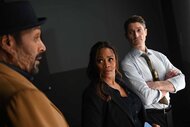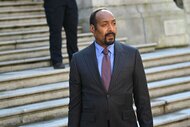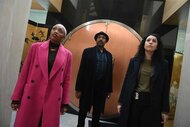Was The Irrational Plane Crash Inspired by a True Story? What to Know
The deadly plane crash in The Irrational was caused by a surprising culprit — and the fictional accident had some chilling similarities to real-life events.
After a plane crashes in the Washington, D.C. area, in the The Irrational Episode 3 "The Barnum Effect", Alec Mercer is tasked with determining whether the disaster was caused by the pilot or something unexpected.
As he dives into the world of aviation, Alec, played by Jesse L. Martin, relies on his impressive behavioral science skills to solve the mystery, meeting a cast of characters with hidden secrets of their own.
Was the plane crash in The Irrational Episode 3 inspired by a true story?
No, the plane crash in The Irrational wasn’t inspired by any specific event.
But the fictional crash did share similarities with a disturbing series of real-life plane crashes that claimed the lives of 346 people and put an aircraft maker in the hot seat.
What caused the plane crash on The Irrational Episode 3?
When a commercial airliner clipped a bridge and crashed into the woods just minutes after take off, initially it wasn’t clear what caused the deadly crash.
The plane’s pilot Lucas, who was killed in the accidet, had been “highly experienced” and had a “perfect flying record,” but the FBI — led by Alec’s ex-wife Marisa (Maahra Hill) — also wasn’t able to rule out the possibility that Lucas had purposely downed the plane in a final suicidal act after going through a difficult divorce.
There were no initial signs of a mechanical problem with the plane and Lucas had seemingly veered off course toward a river just minutes into the flight.
Yet Lucas’ brother Rory, played by Jake B. Miller, insisted that there was “no way that Lucas would intentionally crash a plane.” With the help of Alec and his team, Rory, a pilot himself, set out to clear his brother’s name, even stepping into a flight simulator to relive the final moments of flight using data from the black box retrieved from the wreckage.
While Rory played out scenario after scenario with Alec’s research assistants Phoebe (Molly Kunz) and Rizwan (Arash DeMaxi), Alec confronted Owen Kalagian (Josh Blacker), a supervisor with the plane’s manufacturer, at a local bar.
Just moments before the crash, Lucas may have delivered a telling clue, seemingly saying in the audio footage from the plane that there had been an “Atmos failure,” a reference to the automated control system that runs in every plane made by the manufacturer.
Owen confessed to Alec that the manufacturer realized just weeks earlier there had been an issue with Atmos.
“Grounding the planes would have cost hundreds of millions,” he said, adding that an update to the firmware to fix the problem was expected to be done in less than a week.
Dale (John Shaw), a regulator with the NTSB, had promised the company he “wouldn’t report the problem if we paid him off and fixed it” and a coverup was hatched. Meanwhile, after running one final simulation, Rory discovered the issue with Atmos had been responsible for his brother’s crash. Not realizing Dale’s role in the coverup, he went to the NTSB regulator to reveal the deficiency he found.
RELATED: Where Does The Irrational Starring Jesse L. Martin Take Place, and Where Did it Film?
“I ran the sim without the software update and it turns out there was a calibration error following wind sheer,” Rory later explained to Dale. “The plane has time to compensate at high altitude, but during take off, Atmos was forcing the nose into the ground. That’s why Lucas switched to manual. He didn't have time to explain any of this because he only had seconds to steer toward the river to attempt a water landing.”
Dale made one last attempt to hide his role in the deception, but the FBI quickly moved in and arrested him.
Have there been similar events to the plane crash in The Irrational?
The events in The Irrational were fictional, but they did have some chilling similarities to a real life scandal.
Less than a year apart, two commercial Boeing 737 MAX planes crashed overseas, killing 346 people and ultimately revealing a fatal flaw within Boeing’s software program, known as the Maneuvering Characteristic Augmentation System (MCAS).
According to NBC News, the first plane operated by Lion Air crashed in Indonesia in October of 2018 killing all 189 people on board. Months later, in March of 2019, another Boeing 737 MAX crashed into a field in Ethiopia just minutes after take off, killing another 157 people.
In both instances, the MCAS system on the planes received faulty readings from a single sensor, which then pushed the nose of the planes down, sending them into a high-speed dive. The pilots were unable to pull out of the dive and regain control of the plane before the fatal crashes.
Past employees and consumer analysts told CNBC’s “American Greed” that the company, once known for excellence, had entered a “cut-throat culture of cost-cutting” after a merger with McDonald Douglas in 1997. Boeing was also feeling pressure to compete with rival airline maker Airbus and allegedly rushed the introduction of the 737 MAX.
After the first crash in Indonesia, the SEC would later accuse the company of misleading its investors by insisting that the plane was “as safe as any airplane that has ever flown the skies,” despite already having knowledge of the design flaw, per NBC News.
In 2021, Boeing agreed to pay $2.5 billion to settle a Justice Department investigation into the company’s actions after concluding they had misled the Federal Aviation Administration, according to The Associated Press.
“Boeing’s employees chose the path of profit over candor,” acting assistant attorney general David Burns said at the time.
The scandal received international attention, but the 737 MAX crashes weren’t the only disasters linked to a plane’s failure.
In 2009, Air France Flight 447 crashed into the Atlantic Ocean, killing all 228 people on board, after the plane’s pitot tubes froze and malfunctioned, leading to other complications in the plane’s operations, according to Popular Mechanics.
RELATED: So, What Does "the Cocktail Party Effect" Mean? Defining the Science on Irrational
Swissair’s Flight 111 crashed into the Atlantic Ocean just shy of Nova Scotia in 1998, killing all 229 people on the flight. The crash was later linked to a malfunction within the electrical system of the plane’s entertainment network, causing a fire. Two years earlier, faulty wiring was also linked to the 1996 explosion of TWA Flight 800. All 230 people aboard the Paris-bound flight were killed in that crash.
To find out what mystery Alec and his research assistants tackle next, tune in to The Irrational Mondays at 10/9c on NBC or available streaming the next day on Peacock.

